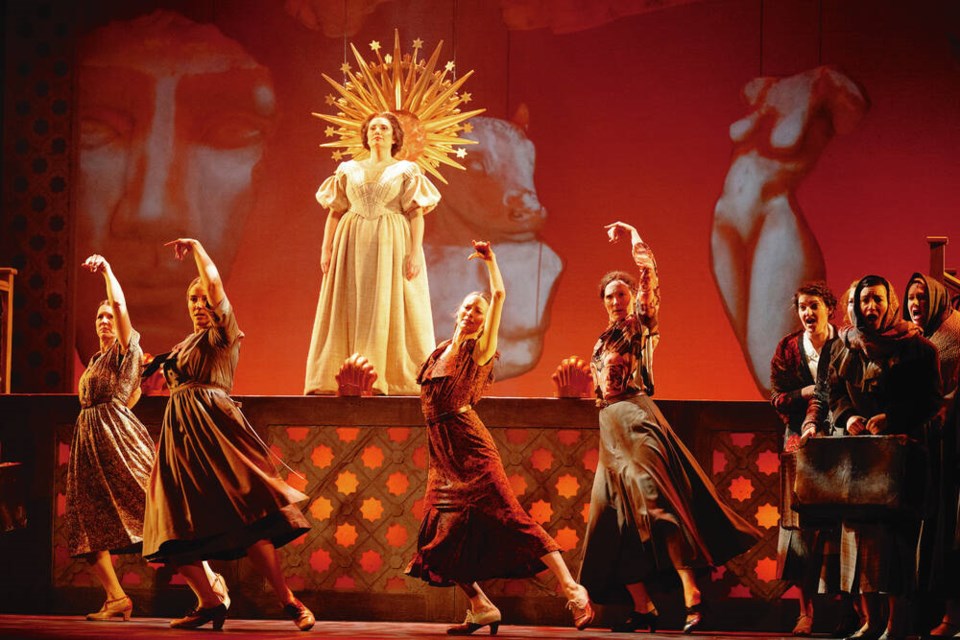Pacific Opera Victoria is serving up a boldly varied menu this season. And so far, it’s working out just fine and dandy.
The company’s last offering was an ambitious interpretation of Wagner’s four-hour masterpiece Die Walküre. POV has now cooked up something that’s entirely different — and definitely shorter.
Ainadamar is a one-act, 80-minute opera composed by Osvaldo Golijov. It’s as deeply Spanish as Die Walküre is deeply Germanic. The opera premiered in 2003, well over a century after Die Walküre’s debut.
Despite fundamental differences in tone and subject matter, both works are invigorating and thrilling. Each glitters with its own strange, unearthly beauty.
Featuring a libretto by David Henry Hwang (who also wrote the play M. Butterfly), Ainadamar centres on the life and murder of poet/playwright Frederico Garcia Lorca, one of Spain’s most celebrated artists.
Oddly, while Lorca’s presence is paramount, he isn’t the main character. The opera pivots around Spanish actress Margarita Xirgu (well sung by soprano Mariam Khalil). A close friend of Lorca’s, Xirgu was renowned for performing the role of Mariana Pineda, the poet’s life-long artistic muse, in a play of the same name.
As the opera begins we meet Xirgu, who’s just finished a performance of the play. She shares her memories of Lorca with a student, Nuria, played by soprano Sarah Shafer.
Their exchange is preceded by images and videos that set the opera’s tone. We see 1930s propaganda posters (Lorca was executed by fascists during the Spanish Civil War). We see soldiers pointing rifles at defenceless women. We experience the sounds and sights of marching, of horses’ hooves squelching through mud. The women sing of the death of Pineda, garroted to death in 1831 for refusing to testify against comrades.
In this opening sequence, female flamenco dancers (the show is choreographed by Veronica Maguire) perform to martial rhythms provided by what sounded like castanets.
Xirgu appeared in the middle haloed by a giant Catholic-style nimbus. A powerful singer, Khalil here and throughout offered pleasingly rounded tones contrasted by passages revealing an edgy dramatic heft. Composer Golijov is particularly fond of sustained high notes, (nicely navigated by Khalil) that emphasize Ainadamar’s surreal, other-worldly feel.
One of the opera’s great strengths is its ability to convey beauty within an atmosphere of cruelty, destruction and death. There’s something uniquely Spanish about all of this. Nowhere is the beauty-within-tragedy theme conveyed more effectively than in the final scenes. As Lorca and two other prisoners are gunned down by soldiers, a lone flamenco dancer performed to the sound of gunshots that transform into a funky percussive rhythm. On Wednesday night this sequence, starkly and brightly lit, was deeply potent.
The score is unusual — a cultural stew that’s earthy, rich, exotic. Elements of the Western classical music tradition are present yet we also hear klezmer, Latin American and Spanish influences. There are hints of jazz — trumpet mutes used wah-wah style or trombones and strings that glissando thrillingly.
Nothing in Ainadamar captures the dark, strange and beautiful soul of Spain more than Alfredo Tejada. The flamenco singer plays Ruiz Alfonso, the fascist politician who ordered Lorca’s death. Costumed like a tin-pot dictator, Alfonso, wheeled in on a wooden staircase, unleashed a primal, melismatic howl that was nothing short of unworldly.
“I give you permission to kill them like dogs,” he declared, adding, “Long live death!”
Mezzo soprano Hannah Hipp played the breeches role of Lorca in plus-fours and a jaunty bowtie. She sang confidently and well, projecting the strong stage presence necessary to make the character work. This was especially evident during the finale when a hooded Lorca meets his maker. No less strong was Shafer as Nuria, a somewhat thankless supporting role that’s mostly reactive.
The Victoria Symphony, conducted by Giuseppe Petraroia, navigated a challenging and unorthodox score with aplomb.
Designer Brian Staufenbiel (who also directs) imaginatively employs video and graphic elements to make a simple set shudder to life. The backdrop was typically dominated by large sculptural fragments depicting such things as a horse and a minotaur. Staufenbiel uses colour and light to great effect. There’s an unforgettable scene in which Lorca seemed to hover above the stage within a subaquatic environment tinctured a gorgeous sapphire blue.
Occasionally the stage direction seemed static. A few sequences, particularly those featuring a full chorus (which sang very well) had a stand-and-deliver feel. And the end of the opera, following Lorca’s death, seemed go on a bit longer than necessary.
Overall Ainadamar is a remarkable work well worth seeking out. It continues tonight, Sunday and Tuesday.



